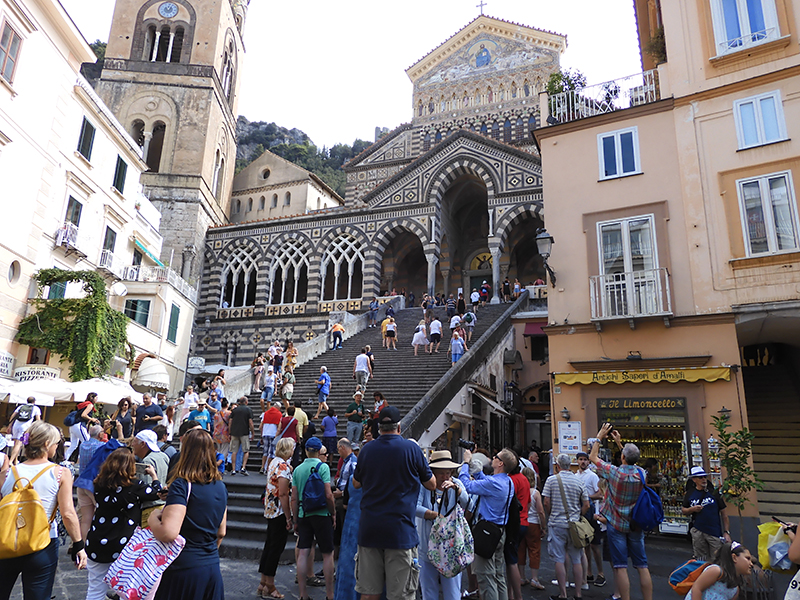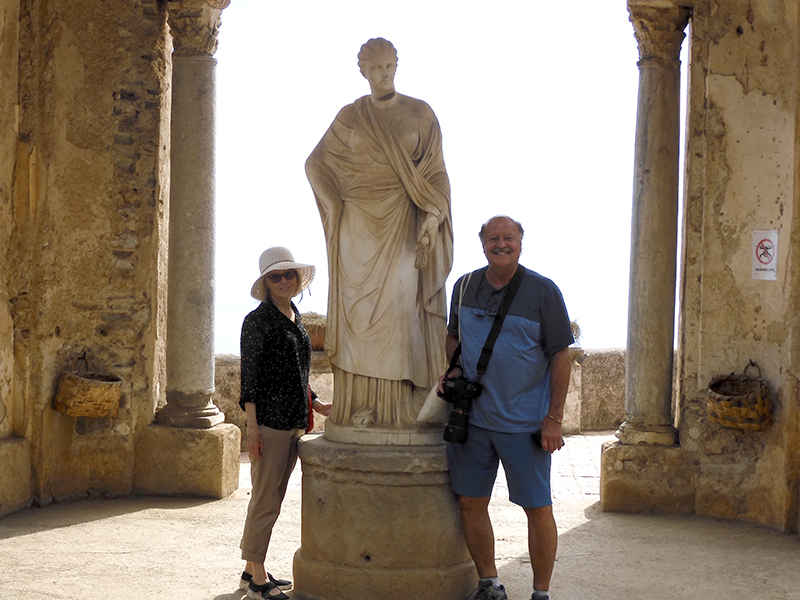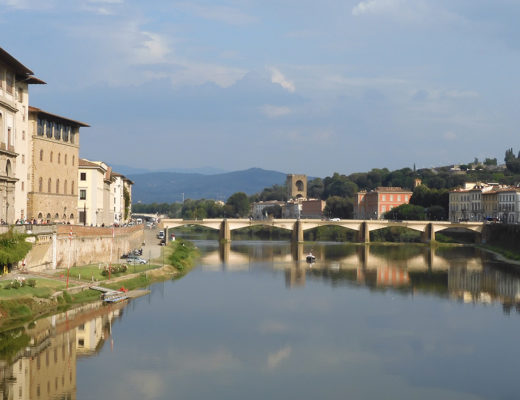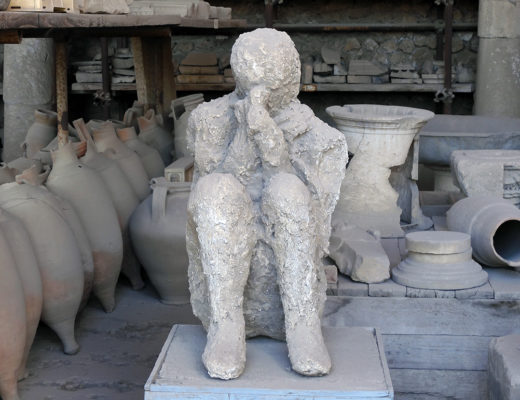We descended the four hundred (estimated by Gil, one member of our party) from the apartment to the main beach in Positano where we picked up a high-speed ferry to Amalfi, a trip of about thirty minutes. The cost of the trip was eight Euros per person and brought us into the main shopping area and port in Amalfi.

This city is most noted for the Cathedral of St. Andrew, which is an intricately decorated house of worship, both inside and outside. It became quite controversial for the distinctly Moorish architectural features, which caused the parishioners to build a second, less ornate, chapel. It houses the relics of St. Andrew in the crypt below the church. Located on the first square as one enters the seafront gate, a statue and fountain to St. Andrew points the parishioners towards the long stairway that leads to the green copper main doors, which are no longer used. A controversial feature of the fountain is the water spouts that emanate from the breasts of the lone carved woman. This feature distracts from the depiction of St. Andrew, who is the patron saint of Amalfi and is described as the third disciple of Christ by the tour guides.

We walked the main street up to the end of the commercial section where we discovered a small village depiction cut into the stone wall. The primary feature of this tiny village was a representation of the Christ child in a manger with his parents and worshippers about. We have seen similar representations in Positano and elsewhere in the Amalfi area.
Amalfi, for us, apart from the cathedral seems similar to the other small cities along the coast south of Naples. While we encountered only a few chain stores, per se, it seems that we could find most of the same goods in every town, as if they all purchase from the same suppliers. There was little we found in Amalfi that would draw us back once we had seen the cathedral.
Antonio, the driver from Positano Car Service, drove from Positano to find us in the port area. He drove us up to Ravello. This was not a long drive from Amalfi, but it took a while as the roads stop traffic in sections to permit alternating one-way movement of vespas, motorcycles, cars, full sized tour buses and delivery vans, often creating long waiting lines.
Once we arrived, we arranged a short visit with Antonio, expecting we could visit Villa Cimbrone in a short amount of time. We did not realize the long trek one has to make on foot from the drop off point to the villa itself. Having spent a week at Villa Collalto in Tuscany the week before, we were all anxious to visit the villa here to compare. We were disappointed to learn the villa is now a hotel and not open to the public unless a registered guest. So we were limited to the garden tour (seven euros per person). We learned that this particular place has roots that go back to Roman times when it was a source of timber for naval vessels, was purchased by a noble family in the eleventh century, passing through the hands of several other wealthy families until 1904 when Ernest William Beckett, Lord Grinthorpe, purchased the land. With the help of a local man by the name of Nicola Mansi, he began the long journey to restoring the estate to a grand Roman Villa.
The gardens have many areas of interest, but probably the best known is the Terrace of Infinity which features well-worn 18th century busts in a row as one overlooks the sea towards the tip of Licosa which is miles away. The high elevation makes it seem that the view goes on forever. There are other areas of interest. The first is The Cloister just inside the 16th century doorway which combines Arabian, Sicilian and French Norman features. This stands next to the entrance to the Crypt, built between 1907 and 1911, which became a meeting place for London’s Bloomsbury Group. The Avenue of Immensity has features that date back to the 17th century, and was a place of inspiration for Richard Wagner and his wife. The Statue of Ceres, goddess of the harvests, is located in a special area adjacent to the Terrace of Infinity which prepares one for the spectacular views one will encounter next.
Leaving the Terrace of Infinity we found Hermes at Rest, a bronze from the 18th century located in an area known as Mercury’s Seat. This is an area that D.H. Lawrence visited often and found much inspiration from. Next is the temple of Bacchus, which features a bronze of Bacchus holding a bunch of grapes supported by a Satyr, which is where Lord Grinthorpe’s ashes are buried. Leaving this inspirational place, we found a natural cave where a statue of Eve appears, who is apparently surprised by our presence as she is naked. The sculpture was by Adamo Tadolini (1788-1868). Following our unexpected visit with Eve, we entered a garden that leads to a rock garden where sits a bronze of David by Gioacchino Varlese, a sculptor from Naples that closely resembles the version found in the national museum in Florence.
The Rose Terrace contains four ornamental statues, those of Flora, goddess of Flowers and Spring, Leda with Swan, and two wrestlers: Damosseno and Greucante. The next feature is the Tea-room, which is a more recent addition to the estate, but features there have been dated to the 12th century. It includes baptismal fonts that are identical to those found in St. Peter’s Church in Cambridge. The final garden area is the Hortensia Avenue which attempts to recapture the grandeur of the Medici gardens in Florence. It incorporates both a representation of Donatello’s David and an old cast iron well.
While I have not attempted to capture the nature of the flowers and fauna that define the gardens themselves, I can only say that the beauty of them is amazing with trees and bushes often exceeding a century in age and maturity.





No Comments